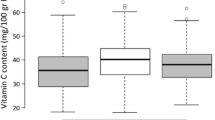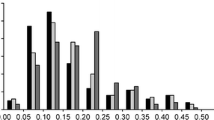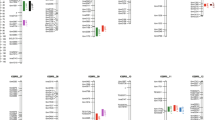Abstract
The goal of this study was to estimate the single and joint effect of the basal region of chromosome 2 and centromeric region of chromosome 8 on morphological and fruit quality traits in tomato (Solanum lycopersicum). The analysis was performed in a population derived from a cross between Rio Grande of S. lycopersicum and LA1589 of S. pimpinellifolium that segregates for both genomic regions. Four major QTLs were found on chromosome 2 and three on chromosome 8, all of them related with morphological traits. QTLs for fruit shape index, proximal fruit end angle and distal fruit end protrusion showed epistatic interaction. Both genomic regions (fs2.1 and fs8.1) explained 62, 47 and 46 % of the phenotypic variability for fruit shape index, proximal fruit end angle and distal fruit end protrusion respectively. Minor QTLs were detected for other morphological and quality traits such as color, pH and fruit shelf life on chromosomes 2 and 8. Only single genomic region effects were found for quality trait. On the other hand, fs2.1 and fs8.1 regions control several fruit morphology attributes following a digenic linear additive model with epistatic interactions.




Similar content being viewed by others
Abbreviations
- a/b :
-
Color chroma index
- ANOVA:
-
Analysis of variance
- ar :
-
Fruit area
- BC1 :
-
First cycle of backcross
- CAPS:
-
Cleaved amplified polymorphic sequences
- dan20 :
-
Distal fruit end angle
- dblk20 :
-
Distal fruit end blockiness
- f :
-
Firmness
- F3 :
-
Third filial generation
- fs I :
-
Fruit shape index
- fw :
-
Fruit mass
- H2 :
-
Broad sense heritability
- InDel:
-
Insertion/deletion
- L :
-
Lightness color parameter
- LL:
-
Homozygous for Rio Grande alleles
- LP:
-
Heterozygous
- pan20 :
-
Proximal fruit end angle
- pblk20 :
-
Proximal fruit end blockiness
- pH :
-
Hydrogen potential
- PP:
-
Homozygous for LA1589 alleles
- QTL:
-
Quantitative trait loci
- S1 :
-
First selfed generation
- sl :
-
Fruit shelf life
- ssc :
-
Soluble solid content
- ta :
-
Titratable acidity
- tip :
-
Distal fruit end protrusion
- tri20 :
-
Fruit shape triangle
References
Bernacchi D, Beck-Bunn T, Eshed Y et al (1998) Advanced backcross QTL analysis in tomato. I. Identification of QTLs for traits of agronomic importance from Lycopersicon hirsutum. Theor Appl Genet 97:381–397. doi:10.1007/s001220050908
Buescher RW, Sistrunk WA, Tigchelaar EC, Ng TJ (1976) Softening, pectolytic activity, and storage-life of rin and nor tomato hybrids. HortScience 11:603–604
Causse M, Chaïb J, Lecomte L et al (2007) Both additivity and epistasis control the genetic variation for fruit quality traits in tomato. Theor Appl Genet 115:429–442. doi:10.1007/s00122-007-0578-1
Cheverud JM, Routman EJ (1995) Epistasis and its contributions to genetic variance components. Genetics 139:1455–1461
Di Renzo JA, Casanoves F, Balzarini MG, Gonzalez L, Tablada M, Robledo CW (2001) Infostat, versión 2001, Grupo Infostat, FCA. Universidad Nacional de Córdoba, Argentina
Frary A, Nesbitt TC, Frary A et al (2000) fw2.2: a quantitative trait locus key to the evolution of tomato fruit size. Science 289:85–88. doi:10.1126/science.289.5476.85
Georgelis N, Scott JW, Baldwin EA (2006) Inheritance of high sugars from tomato accession PI 270248 and environmental variation between seasons. J Am Soc Hortic Sci 131:41–45
Gonzalo MJ, van der Knaap E (2008) A comparative analysis into the genetic bases of morphology in tomato varieties exhibiting elongated fruit shape. Theor Appl Genet 116:647–656. doi:10.1007/s00122-007-0698-7
Grandillo S, Tanksley SD (1996) QTL analysis of horticultural traits differentiating the cultivated tomato from the closely related species Lycopersicon pimpinellifolium. Theor Appl Genet 92:935–951. doi:10.1007/BF00224033
Grandillo S, Ku HM, Tanksley SD (1999) Identifying the loci responsible for natural variation in fruit size and shape in tomato. Theor Appl Genet 99:978–987. doi:10.1007/s001220051405
Jana S (1972) Simulation of quantitative characters from qualitatively acting genes. Theor Appl Genet 42:119–124
Kruskal WH, Wallis WA (1952) Use of ranks in one-criterion variance analysis. J Am Stat Assoc 47:583–621
Ku HM, Grandillo S, Tanksley SD (2000) fs8.1, a major QTL, sets the pattern of tomato carpel shape well before anthesis. Theor Appl Genet 101:873–878
Lippman ZB, Tanksley SD (2001) Dissecting the genetic pathway to extreme fruit size in tomato using a cross between the small-fruited wild species Lycopersicon pimpinellifolium and L. esculentum var. Giant Heirloom. Genetics 158:413–422
Liu J, Van Eck J, Cong B, Tanksley SD (2002) A new class of regulatory genes underlying the cause of pear-shaped tomato fruit. Proc Natl Acad Sci U S A 99:13302–13306. doi:10.1073/pnas.162485999
Mariotti JA, Collavino NG (2014) Los caracteres cuantitativos en la mejora genética de los cultivos. Orientación Gráfica Editora, Buenos Aires
Nesbitt TC, Tanksley SD (2002) Comparative sequencing in the genus Lycopersicon : implications for the evolution of fruit size in the domestication of cultivated tomatoes. Genetics 162:365–379
Pereira da Costa JH, Rodríguez GR, Pratta GR et al (2013) QTL detection for fruit shelf life and quality traits across segregating populations of tomato. Sci Hortic 156:47–53
Pratta GR, Rodríguez GR, Zorzoli R et al (2011) Phenotypic and molecular characterization of selected tomato recombinant inbred lines derived from the cross Solanum lycopersicum × S. pimpinellifolium. J Genet 90:229–237
R Core Team (2014) R: a language and environment for statistical computing. R Foundation for Statistical Computing, Vienna. http://www.R-project.org/
Rodríguez GR, Pratta GR, Zorzoli R, Picardi LA (2006) Evaluación de caracteres de planta y fruto en líneas recombinantes autofecundadas de tomate obtenidas por cruzamiento entre Lycopersicon esculentum y L. pimpinellifolium. Ciencia e Investigación Agraria 33:133–141
Rodríguez GR, Pratta GR, Liberatti DR et al (2010a) Inheritance of shelf life and other quality traits of tomato fruit estimated from F1’s, F2’s and backcross generations derived from standard cultivar, nor homozygote and wild cherry tomato. Euphytica 176:137–147. doi:10.1007/s10681-010-0241-9
Rodríguez GR, Strecker J, Brewer M, et al (2010b) Tomato analyzer user manual version 3
Rodríguez GR, Muños S, Anderson C et al (2011) Distribution of SUN, OVATE, LC, and FAS in the tomato germplasm and the relationship to fruit shape diversity. Plant Physiol 156:275–285. doi:10.1104/pp.110.167577
Saliba-Colombani V, Causse M, Langlois D et al (2001) Genetic analysis of organoleptic quality in fresh market tomato. 1. Mapping QTLs for physical and chemical traits. Theor Appl Genet 102:259–272. doi:10.1007/s001220051643
Schuelter AR, Finger FL, Casali VWD et al (2002) Inheritance and genetic linkage analysis of a firm-ripening tomato mutant. Plant Breed 121:338–342
Shapiro S, Wilk M (1965) An analysis of variance test for normality (complete samples). Biometrika 52:591–611
Simonne AH, Bridget BK, Marshall MM (2006) Consumers prefer low-priced and high-lycopene-content fresh-market tomatoes. HortTechnology 16:674–681
Snedecor G (1964) Métodos Estadísticos, 5ta edn. Compañía Editorial, México
Sun L, Rodriguez GR, Clevenger JP et al (2015) Candidate gene selection and detailed morphological evaluations of fs8.1, a quantitative trait locus controlling tomato fruit shape. J Exp Bot. doi:10.1093/jxb/erv361
Tanksley SD (1993) Mapping polygenes. Annu Rev Genet 27:205–233. doi:10.1146/annurev.ge.27.120193.001225
Tanksley SD (2004) The genetic, developmental, and molecular bases of fruit size and shape variation in tomato. Plant Cell 16:181–189. doi:10.1105/tpc.018119.S182
Xiao H, Jiang N, Schaffner E et al (2008) A retrotransposon-mediated gene duplication underlies morphological variation of tomato fruit. Science 319:1527–1530. doi:10.1126/science.1153040
Author information
Authors and Affiliations
Corresponding author
Electronic supplementary material
Below is the link to the electronic supplementary material.
10681_2016_1689_MOESM1_ESM.jpg
Supplementary material 1 (JPEG 293 kb) Box plot for the markers with significant association and the highest % R2 in the one-way ANOVA for fruit area (ar), fruit shape index I (fs I), proximal fruit end angle (pan20, in °), dital fruit end angle (dan20, in °), and distal fruit end protrusion (tip). Abbreviations: ma ar, m fsI, m pan20, m dan20, and m tip indicates the average values of the population for each trait. a ar_fs2.1, a ar_fs8.1, a fsI_fs2.1, a fsI_fs8.1, a pan20_fs2.1, a pan20_fs8.1, a dan20_fs2.1, a dan20_fs8.1, a tip_fs2.1, and a tip_fs8.1 indicates de additive value for each trait at the genomic regions fs2.1 and f8.1 respectively. LL: homozygous for Rio Grande alleles, LP: heterozygous, PP: homozygous for LA1589 alleles
Rights and permissions
About this article
Cite this article
Green, G.Y., Pereira da Costa, J.H., Cambiaso, V. et al. Single and joint effect of the basal region of chromosome 2 and centromeric region of chromosome 8 on morphological and fruit quality traits in tomato. Euphytica 210, 327–339 (2016). https://doi.org/10.1007/s10681-016-1689-z
Received:
Accepted:
Published:
Issue Date:
DOI: https://doi.org/10.1007/s10681-016-1689-z




